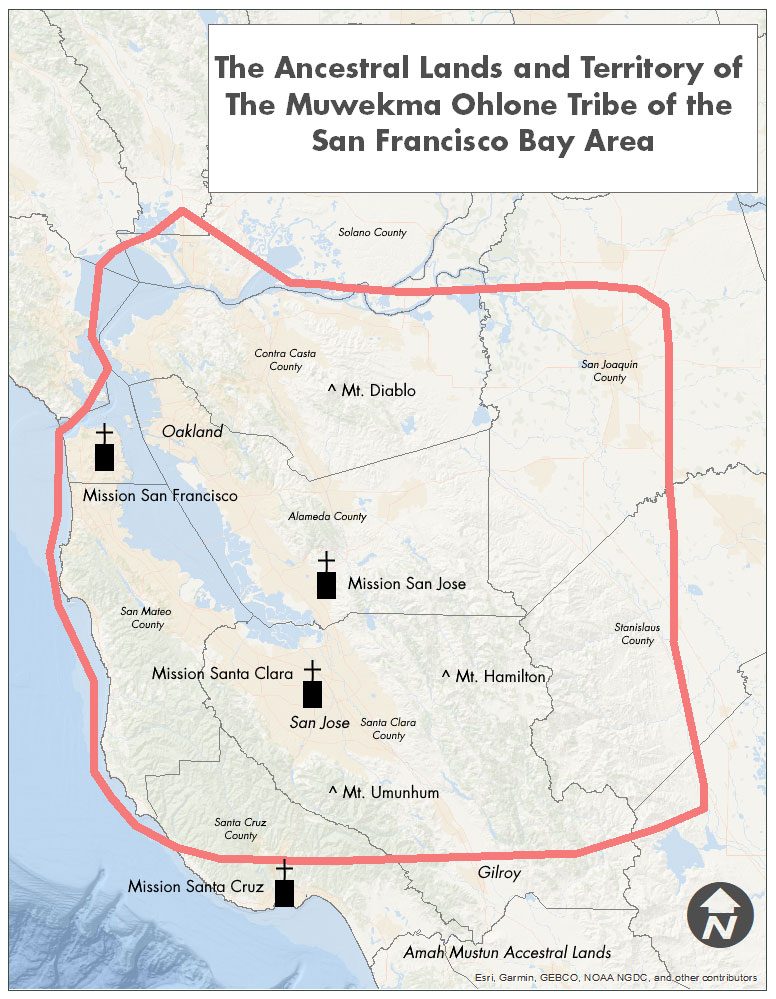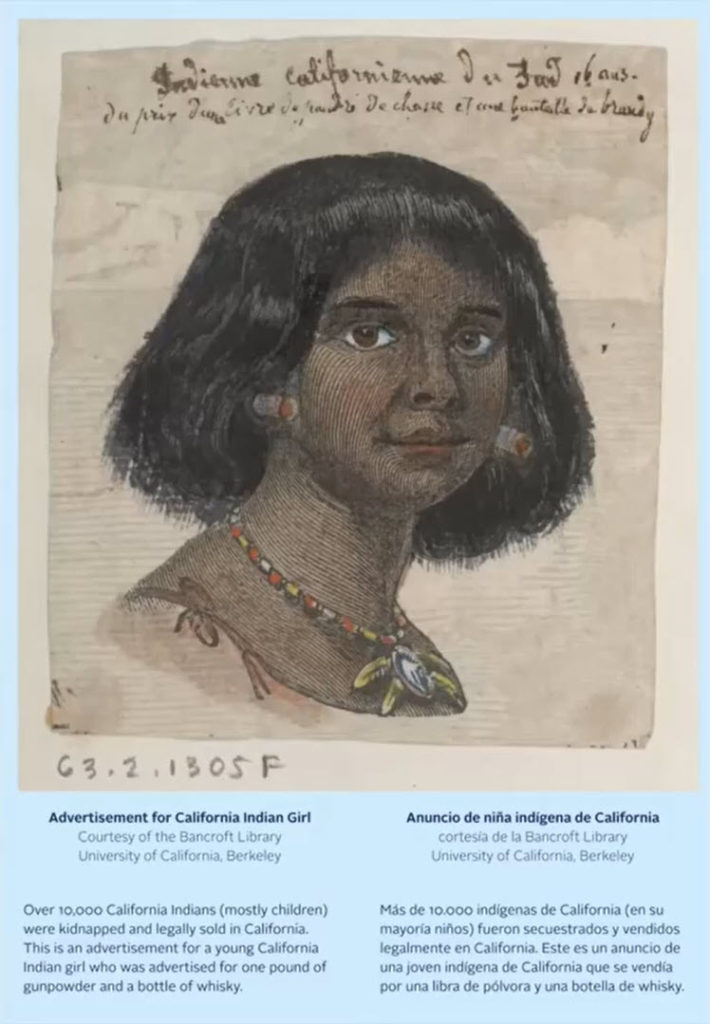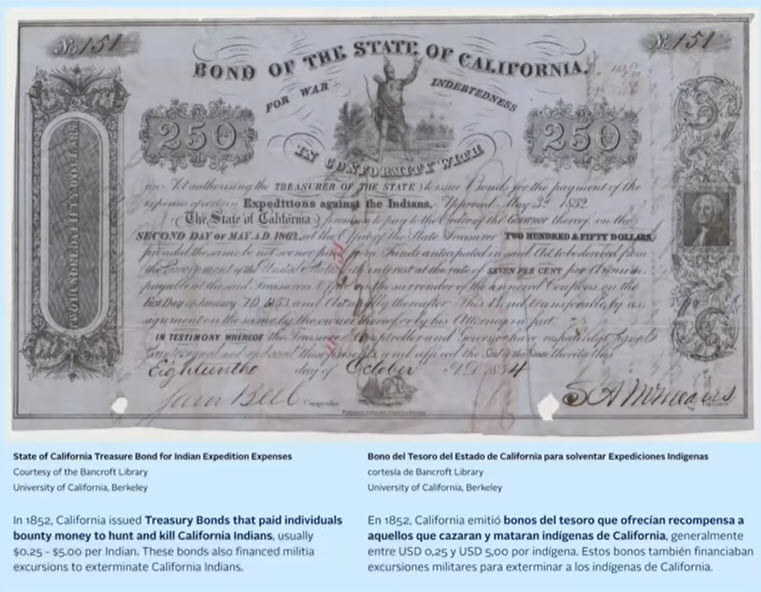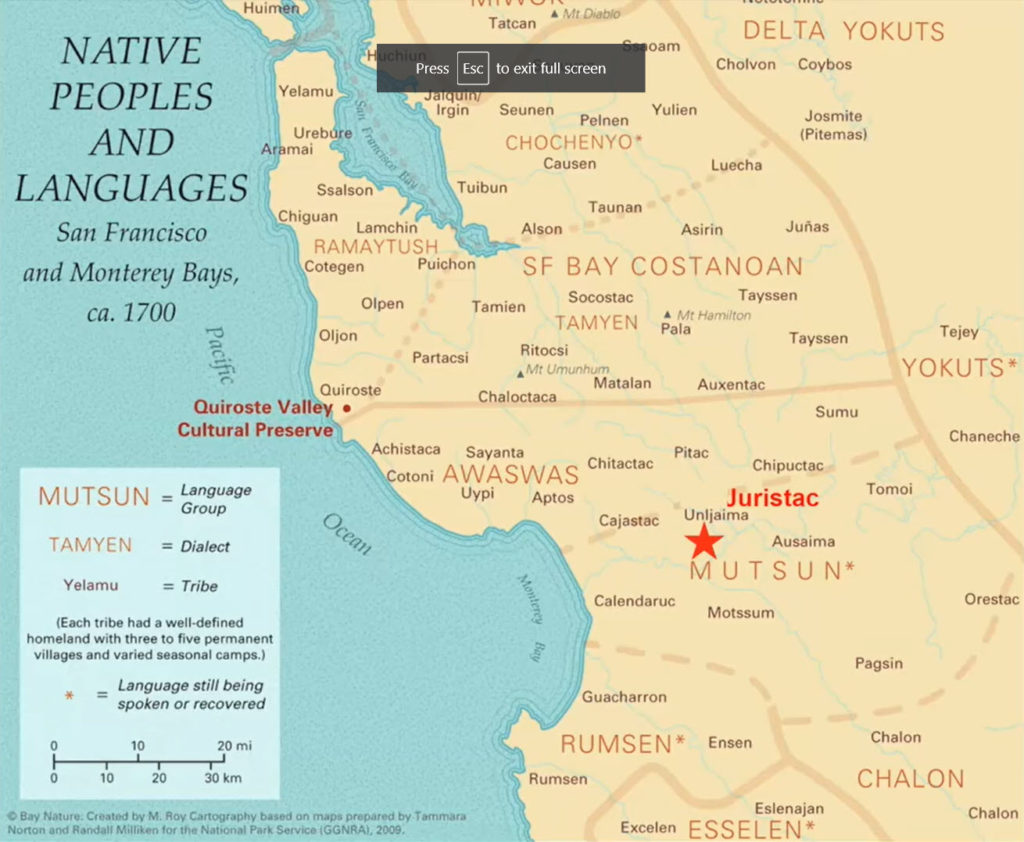Land Acknowledgment
Our Fellowship is located on Ohlone land in the Muwekma Ohlone Tribal Area. We are moved to acknowledge that for thousands of years this land was inhabited by people who lived here peacefully and cared for it in a way that honored all that was here before us, and that they were invaded, forcibly and dishonorably removed from their land, leaving many of them homeless. During multiple waves of colonization, they were systematically murdered and brutally mistreated, and the consequences of that racism and mistreatment continue to this day.
We hope that by stating these facts clearly that we can amplify that truth, learn from their wisdom and that of their ancestors what it means to be stewards of this beautiful land, and be inspired to seriously and thoughtfully consider how we might work to repair those injustices and move forward together in honorable ways.
“When we talk about land, land is part of who we are. It’s a mixture of our blood, our past, our current, and our future. We carry our ancestors in us, and they’re around us. As you all do.” ⏤Mary Lyons (Leech Lake Band of Ojibwe)
Who Are the Muwekma Ohlone?
“Muwekma” means “la Gente” or “the People” in Chocheño and Tamien, the Ohlone languages spoken in the East and South San Francisco Bay regions.
“The present-day Muwekma Ohlone Tribe is comprised of all of the known surviving American Indian lineages aboriginal to the San Francisco Bay region who trace their ancestry through the Missions Dolores, Santa Clara, and San Jose; and who were also members of the historic Federally Recognized Verona Band of Alameda County. The aboriginal homeland of the Muwekma Ohlone Tribe includes the following counties: San Francisco, San Mateo, most of Santa Clara, Alameda, Contra Costa, and portions of Napa, Santa Cruz, Solano and San Joaquin. This large contiguous geographical area, which historically crosscuts aboriginal linguistic and tribal boundaries, fell under the sphere of influence of the aforementioned three missions between 1776 and 1836. The missionization policies deployed by the Catholic Church and militarily supported by the Hispanic Empire, brought many distantly related, and in some cases, already inter-married tribal groups together at the missions.”
—Muwekma Ohlone Tribe of the San Francisco Bay Area
Costanoan (meaning “coast dweller”) was derived from the Spanish name for the Ohlone, and was never a name used by the people themselves.

California Tribe Has New Recognition Hopes After Costly, Two-Decade Struggle, 2014
In the Land of My Ancestors, KQED Truly CA, Ann Marie Sayers, Mutsun/Ohlone in Indian Canyon, Hollister, CA, November 20, 2019
KQED: There Were Once More Than 425 Shellmounds in the Bay Area. Where Did They Go? by Laura Klivans, December 6, 2019
Indigenous History in the Bay Area, webinar series from POST (Peninsula Open Space Trust) with Mark Hylkema, Cultural Resources and Program Supervisor for the Santa Cruz District of California State Parks.
Part 1: Overview, June 12, 2020
Part 2: Ethnobotany and Land Stewardship, June 19, 2020
Part 3: Economy, Spirituality & Culture, June 26, 2020
California’s Treatment of Native Peoples
Library of Congress
Early California History: An Overview
National Park Service, U.S. Department of the Interior
Chapter 9. Ohlone/Costanoans in the United States, 1847-1927
The History Channel
California’s Little-Known Genocide by Erin Blakemore, July 1, 2019
California Slaughtered 16,000 Native Americans. The State Finally Apologized For the Genocide by Erin Blakemore, June 19, 2019
Smithsonian National Museum of the American Indian
Unratified California Treaty K, 1852
California State University Monterey Bay
1851-1852 – Eighteen Unratified Treaties between California Indians and the United States
National Archives
The Secret Treaties with California’s Indians by Larisa K. Miller, archivist, 2013
Why Treaties Matter
Watch this video to learn from Native scholars about land treaties: what they are, why they were signed, and how they continue to impact the United States.
California Research Bureau
Early California Laws and Policies Related to California Indians by Kimberly Johnston-Dodds, September 2002, Prepared at the request of Senator John L. Burton, President Pro Tempore

In just 20 years, 80 percent of California’s Native Americans were wiped out. And though some died because of the seizure of their land or diseases caught from new settlers, between 9,000 and 16,000 were murdered in cold blood—the victims of a policy of genocide sponsored by the state of California and gleefully assisted by its newest citizens.
–Erin Blakemore

Other Local Tribes
The Amah Mutsun Tribal Band is the indigenous group that has lived on the land just south of San Jose for over 10,000 years. The Amah Mutsun are comprised of the descendants of missions San Juan Bautista and Santa Cruz. The traditional tribal territory of the Amah Mutsun extends north into the Coyote Valley which has many culturally important sites. Both the Amah Mutsun and the Muwekma Tribe share responsibility for the protection of these lands.
During the Mission Period (1769-1833), 19,421 Indians died at Mission San Juan Bautista.
See Calls to Action below for information on how you can help the Amah Mutsun in their fight to save Juristac (Huris-tak), the sacred site they lost the right to in 1862, and that is under direct threat from an irresponsible land owner (Debt Acquisition Company of America, or DACA) for a proposed sand and gravel mine to be built on that land.
Click here to view our Letter of Support for the Amah Mutsun Tribal Band in opposing the Sargent Ranch Quarry Project.

Wider Bay Area
Ohlone Costanoan Esselen Nation
Big Sur tribe (Esselen) regains land 250 years after being removed, July 7, 2020
“Now the land, which overlooks the Los Padres National Forest, will remain undeveloped forever. Nason said the tribe, which today has 214 members, will share it with other Central Coast tribes like the Ohlone, the Amah Mutsun and the Rumsen people who also were decimated during the Mission Era.” –Paul Rogers, Bay Area News Group
Lisjan (Ohlone) History & Territory
“Sogorea Te’ Land Trust is based in Huchiun, in unceded Lisjan territory, what is now known as Oakland, Berkeley, Alameda, Piedmont, Emeryville and Albany, California. . . For thousands of years, hundreds of generations, the Lisjan Ohlone people have lived on the land that is now known as the East Bay in the San Francisco Bay Area. We did not own the land, we belonged to it.” (See also: Living on Ohlone Land by Will Parrish in CounterPunch, July 12, 2018)
Federated Indians of Graton Rancheria. “A Restored Tribe Serving Marin and Sonoma Counties.” The Graton Rancheria community is a federation of Coast Miwok and Southern Pomo groups recognized as a tribe by the U.S. Congress.
Photos: Pomo Dreamers and Doctors
Calls to Action
Help Restore Sovereignty to The Muwekma Ohlone Tribe
Support California resolution SJR 13 (Senate Joint Resolution) that was recently introduced by State Senator Dave Cortese and co-authored by Senator Wieckowski and Assembly members Ash Kalra, Alex Lee, and Robert Rivas, which urges the United States Congress and the Department of the Interior and its Bureau of Indian Affairs to reaffirm and restore the Muwekma Ohlone Tribe as a federally recognized Indian tribe and to include the Muwekma Ohlone Tribe in the Federal Register as a recognized tribe.
More information at: http://www.muwekma.org/support-california-resolution.html
Sign the Change.org petition urging California’s legislators to pass the Muwekma Ohlone Tribe resolution SJR 13 at http://www.muwekma.org/sign-the-change.html.
Help Protect Juristac
“Juristac (Huris-tak) lies at the heart of the ancestral lands of the Amah Mutsun Tribal Band near Gilroy, California. For thousands of years, Mutsun ancestors lived and held sacred ceremonies at this location in the southern foothills of the Santa Cruz Mountains, above the confluence of the Pajaro and San Benito rivers.
The cultural landscape encompassing Juristac is known today as the Sargent Ranch. An investor group based in San Diego purchased the land at a bankruptcy auction and is currently seeking to develop a 320-acre open pit sand and gravel mining operation on the property.”
- See http://www.protectjuristac.org/about/ to learn more about the historical, spiritual, and ecological importance of this site.
- Sign the petition at http://www.protectjuristac.org/petition/
- Call, email, or write to Santa Clara County Planning Commissioners and Supervisors asking them to deny approval of the Sargent Quarry Project, protect and preserve Juristac, and recognize that Mutsun spirituality is equal to other religions of the world. Contact information for the county and other ways to help are available at http://www.protectjuristac.org/how-to-help/.
IPOC: Indian People Organizing for Change
Indian People Organizing for Change (IPOC) is a community-based organization in the San Francisco Bay Area. Its members, including Ohlone tribal members and conservation activists, work together in order to accomplish social and environmental justice within the Bay Area American Indian community. Current projects include the preservation of Bay Area shellmounds, which are the sacred burial sites of the Ohlone Nation, whose homeland is the San Francisco Bay Area. See http://ipocshellmoundwalk.homestead.com/
Shuumi Land Tax
“The Shuumi Land Tax is a voluntary annual contribution that non-Indigenous people living on traditional Lisjan Ohlone territory make to support the critical work of the Sogorea Te’ Land Trust.
The Shuumi Land Tax directly supports Sogorea Te’s work of rematriation, returning Indigenous land to Indigenous people, establishing a cemetery to reinter stolen Ohlone ancestral remains and building urban gardens, community centers, and ceremonial spaces so current and future generations of Indigenous people can thrive in the Bay Area. Shuumi means gift in the Ohlone language Chochenyo.”
Additional Video Resources
- Amah Mutsun Webinars: Learn more about the Amah Mutsun recovering their culture and traditions through the excellent webinars at https://www.amahmutsunlandtrust.org/videos
- “Protecting Sacred Landscapes.” This online event details the cultural and ecological importance of Juristac in Santa Clara County and Medicine Lake in Siskiyou County. The inspirational event was hosted by the Amah Mutsun Tribal Band and Green Foothills. See the video here.
- “Culture & Ecology of Juristac: A Community Panel.” Watch here.
- Documentary film “The Doctrine of Discovery and the Domination Code” with Steve and Shawna Newcomb Q&A. Watch here.
- Dr. Benjamin Madley book talk American Genocide: The United States and the California Indian Catastrophe. Watch here.
- “People of the Land: Healing From White Supremacy & Colonization” webinar series. Hosted by UUSC, Texas UU Justice Ministry, UU Ministry for Earth, and UUA with the Esto’k Gna (Carrizo/Comecrudo Tribe of Texas). Watch here.
- Award-winning documentary “The Condor & The Eagle.” “Four Indigenous leaders embark on an extraordinary trans-continental adventure from the Canadian plains to deep into the heart of the Amazonian jungle to unite the peoples of North and South America and deepen the meaning of “Climate Justice”. Their path through the jungle takes them on an unexpectedly challenging and liberating journey, which will forever change their attachment to the Earth and one another.” Watch here.
- Documentary film “Gather.” “…an intimate portrait of the growing movement amongst Native Americans to reclaim their spiritual, political and cultural identities through food sovereignty, while battling the trauma of centuries of genocide. Gather follows Nephi Craig, a chef from the White Mountain Apache Nation (Arizona), opening an indigenous café as a nutritional recovery clinic; Elsie Dubray, a young scientist from the Cheyenne River Sioux Nation (South Dakota), conducting landmark studies on bison; and the Ancestral Guard, a group of environmental activists from the Yurok Nation (Northern California), trying to save the Klamath river.” Click here to learn more. “Gather“ is available to stream on iTunes, Amazon, and Vimeo. You can also see it for free on www.kanopy.com, a free service supported by many public libraries.
Recommended Books
These books are recommended by Mark Hylkema, Cultural Resources and Program Supervisor for the Santa Cruz District of California State Parks. He uses these book in the classes he teaches.
Tending the Wild: Native American Knowledge and the Management of California’s Natural Resources by M. Kat Anderson, University of California Press, October 2013 First Edition
Tending the Wild KCET Broadcast Special
California Indians and Their Environment by Kent G. Lightfoot and Otis Parrish, University of California Press, April 2009 First Edition (Essie Pinola Parrish’s son)
A Peterson Field Guide to Western Medicinal Plants and Herbs Paperback – April 18, 2002 by Christopher Hobbs and Steven Foster, Roger Tory Peterson, Editor
An American Genocide by Benjamin Madley, Yale University Press, May 2016
Mabel McKay: Weaving the Dream by Greg Sarris, University of California Press, February 2013 First Edition (Buy the ebook)
Praise the Rain
by Joy Harjo
Praise the rain, the seagull dive
The curl of plant, the raven talk—
Praise the hurt, the house slack
The stand of trees, the dignity—
Praise the dark, the moon cradle
The sky fall, the bear sleep—
Praise the mist, the warrior name
The earth eclipse, the fired leap—
Praise the backwards, upward sky
The baby cry, the spirit food—
Praise canoe, the fish rush
The hole for frog, the upside-down—
Praise the day, the cloud cup
The mind flat, forget it all—
Praise crazy. Praise sad.
Praise the path on which we’re led.
Praise the roads on earth and water.
Praise the eater and the eaten.
Praise beginnings; praise the end.
Praise the song and praise the singer.
Praise the rain; it brings more rain.
Praise the rain; it brings more rain.
“Praise the Rain,” from Conflict Resolution for Holy Beings: Poems by Joy Harjo. Copyright © 2015 by Joy Harjo. Used by permission of W.W. Norton & Company and the author.
Joy Harjo is the 23rd poet laureate of the United States and a writer of the Muscogee (Creek) Nation. The author of nine books of poetry, including the highly acclaimed An American Sunrise, several plays and children’s books, and two memoirs, Crazy Brave and Poet Warrior. As a musician and performer, Harjo has produced seven award-winning music albums including her newest, I Pray for My Enemies. She is Executive Editor of the anthology When the Light of the World was Subdued, Our Songs Came Through — A Norton Anthology of Native Nations Poetry and the editor of Living Nations, Living Words: An Anthology of First Peoples Poetry, the companion anthology to her signature Poet Laureate project.
She is also a chancellor of the Academy of American Poets and a founding board member of the Native Arts and Cultures Foundation. See JoyHarjo.com.

Facebook
Yelp
YouTube
Meetup